Today's excursion into the Neumark takes us only a few meters from Germany in the city Kostrzyn nad Odrą , the former Kuestrin.
Most Berliners and Brandenburgers is the place almost known through its large bazaar (market) and most visitors
know the city from their shopping tours (now also in more and more "real" shops and supermarkets). Only few of the visitors known that
here is the "Pompeji of the Neumark" with the ruins of the old town Kuestrin.
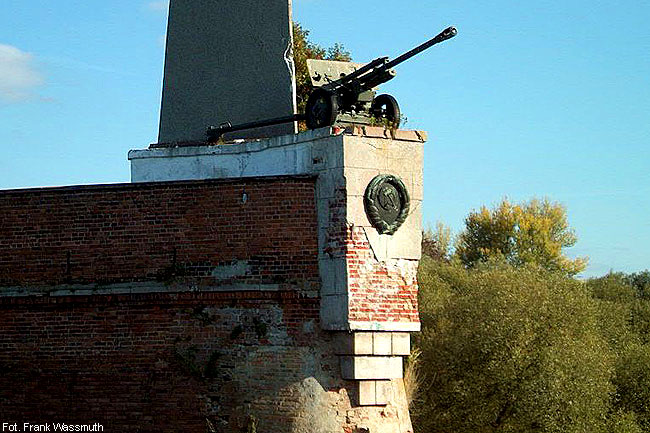
Bastion King of the Kuestrin fortress 2008
with russian memorial and cannon, now
removed
From Berlin, we follow the B1 to Kiez-Kuestrin, where the border is (Warning, keep off to the
speed limits, this route from Germany to the Polish border is "besieged" by mobile controls of the police and the permanently
installed "photo-cameras" of passing municipalities).
Arrived in Kiez-Kuestrin, before the war a suburb of the town Kuestrin (Kostrzyn nad Odra),
we see the big empty barrack complexes which gives us with its spooky image foretaste
of the trip offer we want to do today. These are former barracks of the Reichswehr and Wehrmacht (the german armed forces in the
first and second world war), which was later used by russian troops, and today they are waiting for a new civil use.
Left of the road you will see the frontier of the railway station, now its lost its significance as a border control station.
We cross the Odra and the border. Already at the passing of the old bridge you will see on the right the first bastion of
the fortress of Kuestrin.
Once this site was guarded by the military, until the beginning of 2009 it was decorated by a Soviet memorial to Germany
with threatening directed cannon (photo from memorial and cannon is from autumn 2008).
The memorial has been relocated and the gun removed.
Kuestrin is the only city in Germany, which after the war had completely ceased to exist. Only the eastern part called Neustadt
overcomes the war - with serious destructions - and is now called Kostrzyn nad Odra.
Here are a few buildings remain, such as the train station and some residential buildings and the water tower (now an internet cafe and
antenna tower).
The rest of the city after 1945 was in fact no longer exists.
Kuestrin was once a significant, prosperous city, thanks of the Odra river, economically and militarily capable of great importance.
And historically played Kuestrin significant roles several times in German history until the final battle of the 2nd World War II
on the Odra, the city extinguishes.
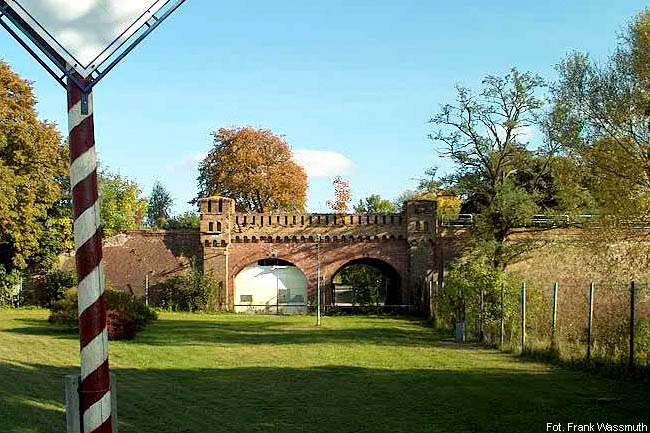
Bastion King with gate, formerly with
tram gate
We want at our today's trip to the Old Town concentrate much more on what is still left.
Unfortunately, it is difficult to find, clearly visible from the Bastion "King" apart.
After passing the border checkpoint, there are two ways to enter the old town. For one, you can go right at Hotel Bastion and
park and from there walk through a path, not marked, with a barrier.
Another possibility is the let the hotel and the shopping center bastion on your right and to go to the roundabout and then
travel further to the right exit.
The leads through a small grove directly on the "back entrance" of the fortress.
How it looks are currently also building measures carried out, to make passable the "front door" near the border crossing for tourists,
but it may take a bit longer, very quickly seem to be the building progresses not to be.
We are approaching from the rear of the fortress and enter through the "Bastion Philipp",
thanks to the EU funding has been reconstructed. From here you have a wonderful view over the Odra river and the size of the fortress
will be viewable.
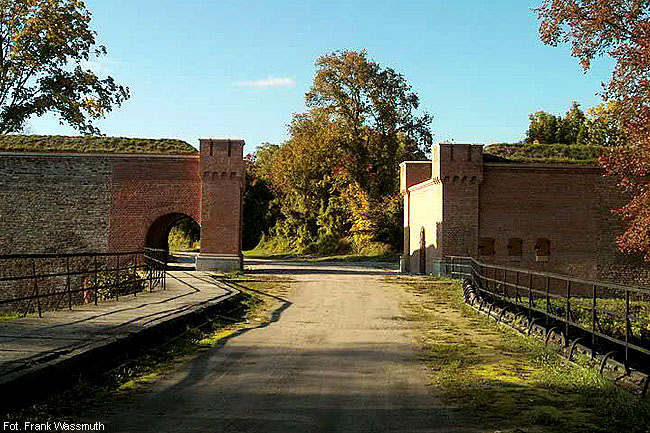
We enter the Old City through the gate
at Bastion Philipp
Surprising is the complete lack of any tourist infrastructure, except for some information tables, there are no tourist facilities
(which are in similar places elsewhere are plentiful). There is neither a cash house, nor souvenirs, restaurants or other. Because
there are no signs to the fortress there, only a few visitors finds the way to the fortress, and you can go alone and undisturbed
on the walls of the fortress.
The lack of infrastructure also has its disadvantages: the roads are bumpy and sometimes it should be used with extreme caution.
It is located here on the ruins of a city, and moves on leaving the streets in old cellars and vaults, which are sometimes holes.
Nevertheless, there is no danger of appropriate vigilance and the trails are well accessible.
We are pretty sure that in the next few years the touristic value of the old town Kuestrin will be detected and until there will be a
ticket shop here, is probably only a matter of time.
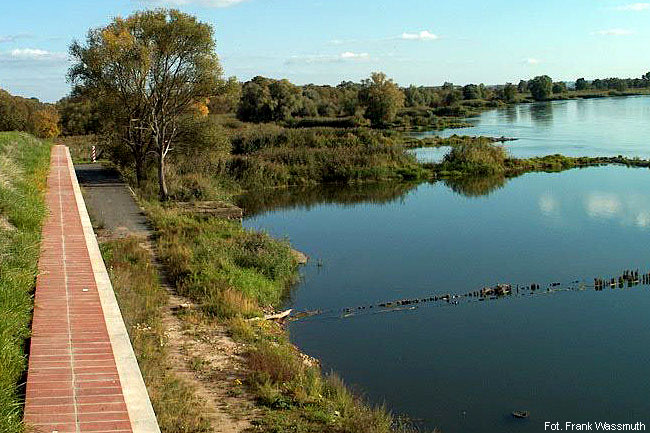
Magnificent views from the ramparts
But first to the city. The old town was completely surrounded by walls at the corners each secured by a bastion.
Later was build buildings outside of the walls, such as new City Hall - about where today the border crossing building. Apart from
the walls and bastions there are no buildings yet. After the passing of the gate of the Bastion "Philipp", we are within the towering
ramparts of the Old Town. We go on paved roads, identify the remains of houses and urban facilities. The feeling that you would on
a walk on a big city map, easily procure us immediately. You can look through the remains of house entrances, see the tiles of the kitchens
of the houses and the remains of the street lights and the tram. The whole city is up on the walls of the
fortress and the bastions at the corners only on the ground out. The streets, squares, foundations of houses are still there, the
rest is missing. Anyone who has visited Pompeii, the Italian city at the foot of the volcano Vesuvius, during a volcanic eruption
in 79 completely destroyed and its ruins today to gain an insight into the former life, feels an instant deja-vu experience.
Also, the old town makes Kuestrin despite all the destruction in many places the impression as if the
residents were abandoned on yesterday.

Impressive: as in Pompeii ruins like
abandoned on yesterday
Its senseful before the visit to view some old pictures (you can find them in Internet or in difficult books, most of them with postcard pictures). With
the pictures in the head its easier, to identify some of the destroyed buildings.
The palace can be identified without problems due its round inn-towers with flights of winding stairs, here you can find the burned rests of the wooden floor cloth and the tiles of the
kitchen. The basement of the memorial can be seen in the middle of the palace.
If your looking the ruins, there will come old stories in your head, which you listened sometimes in the school. This must be the place, where you sitting at the rest of a wall, where
the guard room was, from which the young Friedrich (later king and known as old Fritz) had to look, how its pitiless father let execute his friend Katten, to punish both for their planned
escape from the pressure of the royal life (a follower for the thrown could not be punished with the death of course, but he had to see the execution.
The place behind the palace, were the execution take part, is named Kattenwall, since this time.
A view to the place before the palace lets foreshadow, how busy it must be here in the old times. Tracks in the stones shown, how much horse cars must be come threw this place.
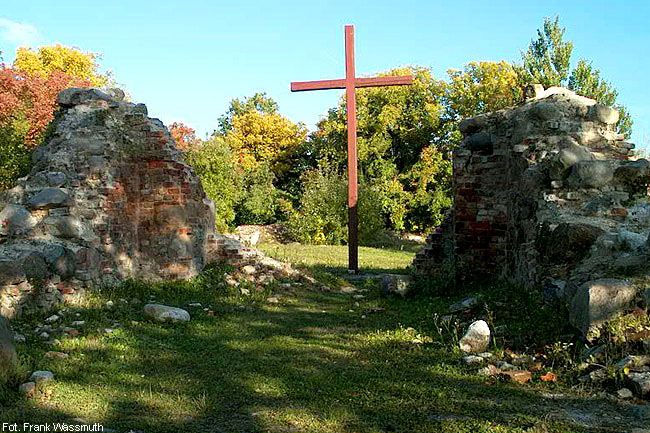
A wooden cross remembers the place
where the church was be
Surrounding wall parts, to which the grenade attacks still discernible, provide a picture of the dark days before the live of the ancient
city Kuestrin completed. Opposite the castle is situated a memory for the victims of the war, a large wooden cross erected where the church was located.
Impressive is a walk through the former church entrance. Stop short before that, what is left from the altar.
In the entrance area are often found flowers or candles, which visitors set to commemorate the died Küstrin peoples .
You can work in one hour around the Old Town, if you want to see more, you should have a little bit more time.
Even here there is next to the historical part a wonderful view over the river Oder. Deep down at the foot of the fortress walls
sit anglers, storks pass, from time to time a boat.

Basement of the memorial for the elector
Friedrich Wilhelm in the palace
The King's Bastion (the border crossing turned) will probably become the official entrance to the "Odra-Pompeji" sometimes.
Here are to detect the first preparations, to create touristic infrastructure.
At the King's Bastion you can go threw the gate. This past even a tram drove through the gate, you know
only through old pictures and on the ceiling still visible fixings for overhead.
Immediately prior was formerly the town hall.
If you leave the Old Town of Kuestrin, you will not only have made a nice walk with some stunning views of the Odra and nature,
you will not go without some of the breath of history with you, which you have felt at every step here.

Kostrzyn, former Kuestriner Neustadt,
only few old buildings between a lot
new buildings
If you are hungry or thirsty after your walk, we suggest a visit at the restaurant of the near Hotel "Bastion", since
2009 with a terrace too.
Should you have some more time, visit the New Town too (go across the market and McDonalds), to have an impression of the "new" Kostrzyn.
Unfortunately there are only a few parts of the old town, but you could look the train station and some old buildings not far from.
Here are some restaurants and shops too. In the middle of the New Town is an old water tower. The big train station, a important
station of the so-called Ostbahn (Eastern Train) shows the importance of the town in old times.
F. Wassmuth, Berlin, 2009